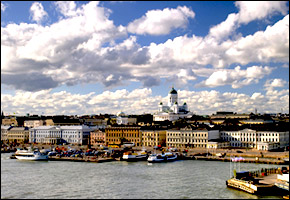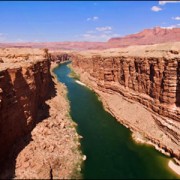‘Risky Business’ Report Says Two Things about Water — One Is Obvious, the Other Is Not
Water is largely ignored in a report about U.S. economic risks of climate change.
Three rich and powerful men — former New York City mayor Michael Bloomberg, former U.S. treasury secretary Henry Paulson, and hedge fund manager Tom Steyer — want business leaders and investors to understand global warming in financial terms: as a significant economic risk.
The report they released this week does this not by tugging at the heartstrings but by pointing to the purse strings. A hotter, drier world where seas lap at oceanfront condos and power plants and where heat stress decreases worker productivity is a world in which investments and profits may fall short of expectations or even, in the case of coastal property, be completely destroyed.
Risky Business is concerned with numbers. The 56-page report, stuffed with graphics and photos, focuses on the economic risks for four areas in which the climate data are clearest:
- Sea level rise and storm surges
- Agricultural production
- Energy demand
- Heat-related changes in labor productivity and health
These areas are also most relevant to the target audience: property tycoons, bond investors, commodity traders, and business managers. And the numbers are quite large.
By 2050, for example, between $US 66 billion and $US 106 billion worth of existing coastal property — hotels, houses, water treatment plants, etc — will be below the average sea level. Five decades later, those figures could increase four- or five-fold, not counting new development.
For agriculture, corn, soybean, and wheat productivity could drop by 50 to 70 percent in the Midwest, southern Plains, and Southeast by the end of the century. With more heat, demand for air conditioning and electricity will soar in many areas and cause residential energy bills to grow, adding between $US 8.5 billion and $US 30 billion to the national electricity bill by mid-century. And there will be extremely hot and humid days where simply being outdoors would be deadly. You can’t roof a house or pave a road in that.
Water, however, is ignored in many of the quantitative assessments. Changes in the amount of available water are important, the report states. But that’s about all it states.
The section on the Southwest gives water availability the most column-inches: one paragraph to set up the region’s water challenges but not analyze them:
“As the Southwest climate heats up, the region is likely to see significantly less snow in the mountains, leading to decreases in spring runoff especially in California and the Southern Rockies. Extreme heat may also lead to higher evaporation of existing reservoirs. This translates into less available groundwater for critical industries such as agriculture, as well as for simple drinking and bathing. Even as temperatures rise, increased energy demand from air conditioning will likely lead to increased water demand, since electricity generation is heavily water-dependent. Decreased water availability is also likely to be the most significant impact on this region’s agricultural industries, which tend to be non-commodity crops (tree nuts, fruits, etc.) and therefore are not included in our quantitative analysis of the agricultural sector.”
Even the agricultural sector analysis is largely based on heat changes and not water changes. And though water is mentioned as a factor in electricity generation, it is not mentioned in the paragraphs about energy production. Much of the new growth in the U.S. fossil fuel industry is occurring in water-stressed areas, notes Ceres, a sustainable business advocacy group.
Matthew Lewis, the report’s spokesman, did not respond to questions about why climate-related water risks were handled this way.
Despite the broad neglect, water does make an unusual appearance: in the sections on rising seas. The report notes that one of the lesser factors in sea-level rise is groundwater pumping along the coasts, which can cause the land to sink in relation to the ocean.
New Jersey, the report claims, will see a greater net sea-level increase than its neighbors because it pumps more groundwater.
Risky Business is notable because of the people backing the project. The report is a worthy nudge to the business community, but more work needs to be done.
Brett writes about agriculture, energy, infrastructure, and the politics and economics of water in the United States. He also writes the Federal Water Tap, Circle of Blue’s weekly digest of U.S. government water news. He is the winner of two Society of Environmental Journalists reporting awards, one of the top honors in American environmental journalism: first place for explanatory reporting for a series on septic system pollution in the United States(2016) and third place for beat reporting in a small market (2014). He received the Sierra Club’s Distinguished Service Award in 2018. Brett lives in Seattle, where he hikes the mountains and bakes pies. Contact Brett Walton









Leave a Reply
Want to join the discussion?Feel free to contribute!